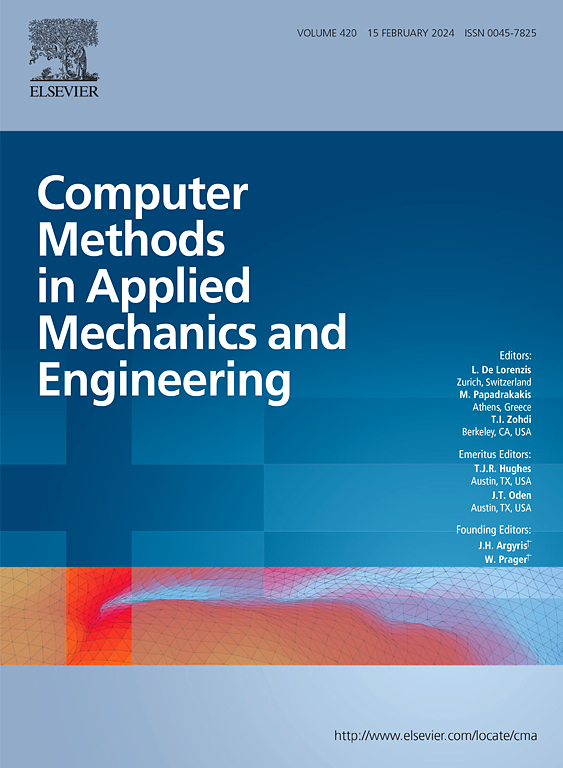皮肤矫形手术力学分析的八面体对称正交离散纤维色散模型
IF 7.3
1区 工程技术
Q1 ENGINEERING, MULTIDISCIPLINARY
Computer Methods in Applied Mechanics and Engineering
Pub Date : 2025-02-12
DOI:10.1016/j.cma.2025.117809
引用次数: 0
摘要
软组织力学行为的高级模拟经常依赖于基于结构的本构模型,包括胶原纤维的涂抹描述。其中,所谓的离散光纤色散(DFD)建模方法是基于光纤应变能在所有光纤方向上的离散积分。在本文中,我们回顾了DFD模型的理论框架,包括有限元实现所需的应力和刚度张量的推导。具体地说,得到了它们在不可压缩平面应力问题中的表达式。然后提出了利用八面体对称建立的列别捷夫正交,说明了积分点方向所采用的特殊选择。接下来,通过三个数值基准测试来评估该正交方案的收敛性,突出了相对于文献中可用的其他角积分方法的优点。最后,利用所实现的模型,我们分析了z -成形术的力学性能,考虑了多种几何构型、纤维方向和皮肤预应力水平。z -成形术是一种常用于重建皮肤手术的技术。结果以与外科实践相关的机械量的形式呈现。本文章由计算机程序翻译,如有差异,请以英文原文为准。
A discrete fiber dispersion model with octahedral symmetry quadrature for mechanical analyses of skin corrective surgeries
Advanced simulations of the mechanical behavior of soft tissues frequently rely on structure-based constitutive models, including smeared descriptions of collagen fibers. Among them, the so-called Discrete Fiber Dispersion (DFD) modeling approach is based on a discrete integration of the fiber-strain energy over all the fiber directions. In this paper, we review the theoretical framework of the DFD model, including a derivation of the stress and stiffness tensors required for the finite element implementation. Specifically, their expressions for incompressible plane stress problems are obtained. The use of a Lebedev quadrature, built exploiting the octahedral symmetry, is then proposed, illustrating the particular choice adopted for the orientation of the integration points. Next, the convergence of this quadrature scheme is assessed by means of three numerical benchmark tests, highlighting the advantages with respect to other angular integration methods available in the literature. Finally, using the implemented model, we analyze the mechanical properties of the Z-plasty, a technique commonly used in reconstructive skin surgery, considering multiple geometrical configurations, orientations of the fibers, and levels of skin prestress. The results are presented in the form of mechanical quantities relevant to surgical practice.
求助全文
通过发布文献求助,成功后即可免费获取论文全文。
去求助
来源期刊
CiteScore
12.70
自引率
15.30%
发文量
719
审稿时长
44 days
期刊介绍:
Computer Methods in Applied Mechanics and Engineering stands as a cornerstone in the realm of computational science and engineering. With a history spanning over five decades, the journal has been a key platform for disseminating papers on advanced mathematical modeling and numerical solutions. Interdisciplinary in nature, these contributions encompass mechanics, mathematics, computer science, and various scientific disciplines. The journal welcomes a broad range of computational methods addressing the simulation, analysis, and design of complex physical problems, making it a vital resource for researchers in the field.

 求助内容:
求助内容: 应助结果提醒方式:
应助结果提醒方式:


